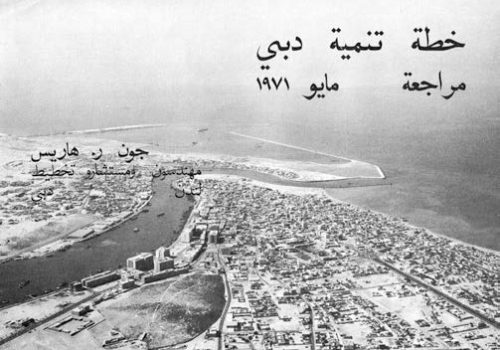Excerpt from article published in Architectural Design, v 81 n 1. Link to download below.
Download article here.
Making plans for cities is usually about establishing and ensuring stability. By the time Dubai’s 1971 masterplan was issued, however, the emirate city’s leadership – namely Sheikh Rashid bin Saeed Al Maktoum – had decided that such a projection of stability was not sensible, even in the face of instability on all fronts. Assertive leadership, British advice and some geopolitical happenstance had made manifest by then a fusion of a pre-modern and modern city along the easily identi able Dubai Creek. Triggered by the tapping of commercial amounts of oil in 1969, the 1971 plan was intended to address the growth predicted to result from oil wealth, but it also came at an inauspicious moment – or maybe that was the point. 1971 marked not only a beginning, but also an end of Dubai as those who knew it knew it.
In 1969, giant oil storage tanks (each larger than any building ever built in Dubai thus far) were launched 19 kilometres (12 miles) from Dubai Creek and floated out to sea. British architect John R Harris, already a decade in consultative service to Sheikh Rashid, and the author of Dubai’s first masterplan, was commissioned to lay out how this new wealth would translate into more tarmac, concrete and steel.[1] By the time Harris delivered the plan, 21 months after the launch of Dubai’s oil industry, there was already an end. The promise of oil was never realised as commercial quantities were limited, and the focus of the new plan shifted to ‘maintaining [Dubai’s] pre-eminent position as a trading centre’ wherein oil wealth would not be necessary.[2]
Notes
1. John Harris was an indubitable presence in Sheikh Rashid’s
management of his city. Sheikh Rashid rst met Harris when
he arrived in Dubai as a prospective candidate to draw the
city’s rst town plan in 1959. Upon agreeing to do this job,
Harris also took on the commission to design the coast’s rst
hospital into something more than a concrete-block shed.
Harris had maintained a recurring and stable presence in
Sheikh Rashid’s ring of advisers and was a close consultant,
if not mentor, to Dubai’s edgling planning department. This
led to Harris’s engagement to draw up Dubai’s 1971 plan. The
author thanks Jill Harris and Mark Harris for their continuing
help and advice for this article.
2. John R Harris Architects and Planning Consultants, ‘Dubai
Development Plan Review’, May 1971. For a published
version of this document’s texts, see John Harris, ‘Dubai
Development Plan Review, 1971’, in Development Plans of the
GCC States, 1962–1995, Archive Editions (Slough, UK), 1994.
